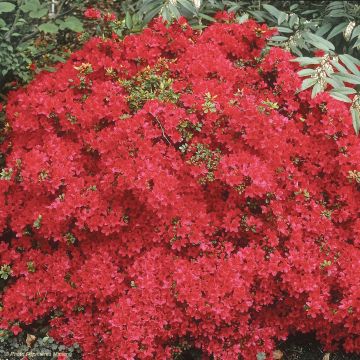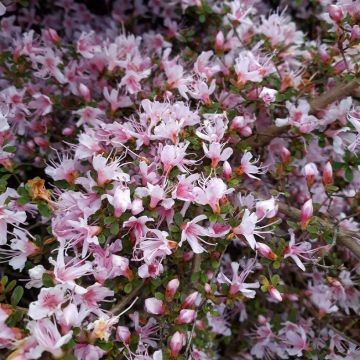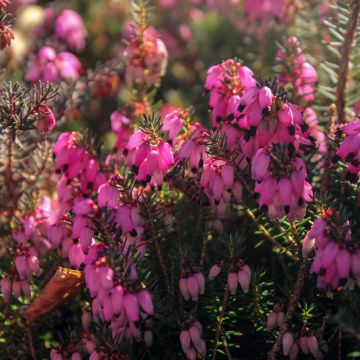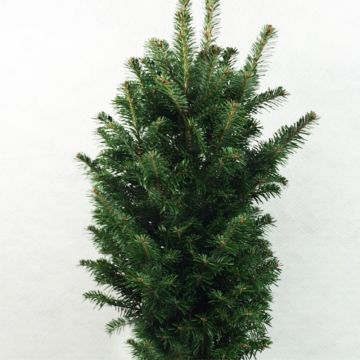

Azalea japonica Blue Danube
Azalea japonica Blue Danube
Rhododendron (Azalea) Blue Danube
Japanese azalea
This item cannot be shipped to the selected country
Delivery charge from €5.90
More information
Schedule delivery date,
and select date in basket
This plant carries a 24 months recovery warranty
More information
We guarantee the quality of our plants for a full growing cycle, and will replace at our expense any plant that fails to recover under normal climatic and planting conditions.
From €5.90 for pickup delivery and €6.90 for home delivery
Express home delivery from €8.90.

Does this plant fit my garden?
Set up your Plantfit profile →
Description
The 'Blue Danube' Japanese Azalea is a real eye-catcher in spring. This dense, low, spreading bush, is striking because of its remarkable blooms consisting of clusters of delightful mauve-violet flowers, speckled with purple-pink and shimmering with beautiful blue highlights, and delicate long pink stamens. They bloom in spring on an elegant, relatively light green foliage, which partially lasts into winter. Highly resistant to the cold, this vigorous variety can be grown in an ericaceous bed in a small Japanese-style garden, or in a carefully chosen pot on the terrace.
The Hybrid Rhododendron 'Blue Danube' Azalea, is a plant from the large Ericaceae family, like the heathers. It is a small, very hardy shrub that thrives in partial shade and lime-free soil that stays moist throughout the year. This Belgian variety dating from 1965 is the result of cross between the Rhododendron 'Malvaticum' and R. kaempferi, a Japanese species. With an award from the Royal Horticultural Society in England, this Azalea is still highly valued for its excellent hardiness (-20°C (-4 °F)), ease of cultivation, and its unusually coloured flowers.
Vigorous but low growing, 'Blue Danube' forms a well-branched dome around 80 cm (31.5 in) high and 1.2 m (3 ft 11 in) in spread at maturity. It generally flowers for 2 to 3 weeks at the end of May. Clusters of 4 to 5 funnel-shaped flowers bloom at the end of the branches, each one measuring 4 to 4.5 cm (1.6 to 1.8 in) wide. Their colour is somewhere between mauve and pink, with beautiful blue highlights and purple speckles at the centre. The foliage of this variety is semi-evergreen with quite wide, elongated, oval-shaped, light green leaves in spring. Those produced in late summer are smaller and a deeper bronze in colour. Slow-growing, this small ericaceous shrub thrives in moist, humus-rich, well-drained, acid soils.
Azaleas grace ericaceous beds all year round with their more or less evergreen foliage, and liven up gardens in spring with their charming and unusual blooms. Plant them in a shady rockery, at the edge of a bed, or in a container alongside Pieris, Kalmia, Heather, Chinese Azaleas, Rhododendrons, dwarf bamboos, Japanese grass Hakonechloa macra, and Japanese Maples. Japanese Azaleas are sometimes grown in pots, but they can also be trained into Bonsai by specialists, becoming beautiful specimens to showcase in a Zen or Japanese-inspired setting.
Report an error about the product description
Azalea japonica Blue Danube in pictures




Plant habit
Flowering
Foliage
Botanical data
Rhododendron (Azalea)
Blue Danube
Ericaceae
Japanese azalea
Cultivar or hybrid
Other Japanese Azalea
Planting and care
Plant the 'Blue Danube' Japanese Azalea in a semi-shaded or shaded position, protected from cold, drying winds, in fresh, humus-rich, light, acid soil. Like all ericaceous plants, it cannot tolerate alkaline soils or heavy soils that are waterlogged in winter. Dig a hole three times larger than the pot. Soak the root ball in lime-free water and plant with the rootball level with the surface of the soil, in a mixture composed of 1/4 coir, leaf mould, horticultural grit or perlite, and loam. Water generously and keep the soil moist in summer. Azaleas and Rhododendrons have a shallow root system. As a result, they are sensitive to long periods of drought. That is why it is recommended to use humus-rich soil and water copioulys during dry periods. Additionally, this root system is not very strong, which is why it is essential to lighten heavy soils with free-draining materials (horticultural grit or perlite, clay pellets) when planting. Apply a mulch of shredded pine bark around the base of the shrub every spring to keep the soil moist while maintaining an acidic pH. Maintenance consists of removing faded flowers in summer and clearing out dead branches. Yellowing of the leaves (chlorosis) in Rhododendrons indicates poor iron uptake from the soil and can cause premature plant death. While lime is often the cause, poorly drained soil or a root ball planted too deeply can also explain the phenomenon.
Planting period
Intended location
Care
-
, onOrder confirmed
Reply from on Promesse de fleurs
Evergreen shrubs
Haven't found what you were looking for?
Hardiness is the lowest winter temperature a plant can endure without suffering serious damage or even dying. However, hardiness is affected by location (a sheltered area, such as a patio), protection (winter cover) and soil type (hardiness is improved by well-drained soil).

Photo Sharing Terms & Conditions
In order to encourage gardeners to interact and share their experiences, Promesse de fleurs offers various media enabling content to be uploaded onto its Site - in particular via the ‘Photo sharing’ module.
The User agrees to refrain from:
- Posting any content that is illegal, prejudicial, insulting, racist, inciteful to hatred, revisionist, contrary to public decency, that infringes on privacy or on the privacy rights of third parties, in particular the publicity rights of persons and goods, intellectual property rights, or the right to privacy.
- Submitting content on behalf of a third party;
- Impersonate the identity of a third party and/or publish any personal information about a third party;
In general, the User undertakes to refrain from any unethical behaviour.
All Content (in particular text, comments, files, images, photos, videos, creative works, etc.), which may be subject to property or intellectual property rights, image or other private rights, shall remain the property of the User, subject to the limited rights granted by the terms of the licence granted by Promesse de fleurs as stated below. Users are at liberty to publish or not to publish such Content on the Site, notably via the ‘Photo Sharing’ facility, and accept that this Content shall be made public and freely accessible, notably on the Internet.
Users further acknowledge, undertake to have ,and guarantee that they hold all necessary rights and permissions to publish such material on the Site, in particular with regard to the legislation in force pertaining to any privacy, property, intellectual property, image, or contractual rights, or rights of any other nature. By publishing such Content on the Site, Users acknowledge accepting full liability as publishers of the Content within the meaning of the law, and grant Promesse de fleurs, free of charge, an inclusive, worldwide licence for the said Content for the entire duration of its publication, including all reproduction, representation, up/downloading, displaying, performing, transmission, and storage rights.
Users also grant permission for their name to be linked to the Content and accept that this link may not always be made available.
By engaging in posting material, Users consent to their Content becoming automatically accessible on the Internet, in particular on other sites and/or blogs and/or web pages of the Promesse de fleurs site, including in particular social pages and the Promesse de fleurs catalogue.
Users may secure the removal of entrusted content free of charge by issuing a simple request via our contact form.
The flowering period indicated on our website applies to countries and regions located in USDA zone 8 (France, the United Kingdom, Ireland, the Netherlands, etc.)
It will vary according to where you live:
- In zones 9 to 10 (Italy, Spain, Greece, etc.), flowering will occur about 2 to 4 weeks earlier.
- In zones 6 to 7 (Germany, Poland, Slovenia, and lower mountainous regions), flowering will be delayed by 2 to 3 weeks.
- In zone 5 (Central Europe, Scandinavia), blooming will be delayed by 3 to 5 weeks.
In temperate climates, pruning of spring-flowering shrubs (forsythia, spireas, etc.) should be done just after flowering.
Pruning of summer-flowering shrubs (Indian Lilac, Perovskia, etc.) can be done in winter or spring.
In cold regions as well as with frost-sensitive plants, avoid pruning too early when severe frosts may still occur.
The planting period indicated on our website applies to countries and regions located in USDA zone 8 (France, United Kingdom, Ireland, Netherlands).
It will vary according to where you live:
- In Mediterranean zones (Marseille, Madrid, Milan, etc.), autumn and winter are the best planting periods.
- In continental zones (Strasbourg, Munich, Vienna, etc.), delay planting by 2 to 3 weeks in spring and bring it forward by 2 to 4 weeks in autumn.
- In mountainous regions (the Alps, Pyrenees, Carpathians, etc.), it is best to plant in late spring (May-June) or late summer (August-September).
The harvesting period indicated on our website applies to countries and regions in USDA zone 8 (France, England, Ireland, the Netherlands).
In colder areas (Scandinavia, Poland, Austria...) fruit and vegetable harvests are likely to be delayed by 3-4 weeks.
In warmer areas (Italy, Spain, Greece, etc.), harvesting will probably take place earlier, depending on weather conditions.
The sowing periods indicated on our website apply to countries and regions within USDA Zone 8 (France, UK, Ireland, Netherlands).
In colder areas (Scandinavia, Poland, Austria...), delay any outdoor sowing by 3-4 weeks, or sow under glass.
In warmer climes (Italy, Spain, Greece, etc.), bring outdoor sowing forward by a few weeks.























































